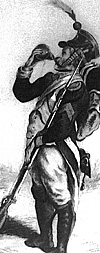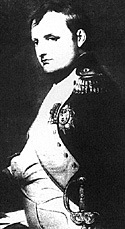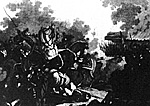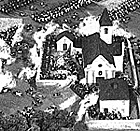The Battle for Aspern Begins
"A Numerous Artillery Ravaged Our Lines"
The Austrians began with the French emigre General Nordmann who conducted an advance guard against Aspern from the west. Simultaneously, a special force commanded by Count Colloredo [probably an officer from Karl's own staff] pressed in along the Danube's bank southwest of Aspern. Colloredo's thrust composed a battalion of the St. George Grenz, a battalion of Viennese volunteers, and a landwehr battalion. Operating as light infantry, this force tried to work its way over the marshy Gemeinde Au.
So surprised were the French,
that the initial Hapsburg assault
found the village garrisoned
by only a few companies of infantry
Potentially, this was the most dangerous thrust of all, for should the attackers prevail here they would have but a short advance to capture the bridgehead itself. But the heavily wooded, marshy terrain well favored French skirmisher tactics. A few companies belonging to the 16th Line initially yielded some ground until retiring behind a wide moat-like ditch (once the main river channel) that bisected the Gemeinde Au. Here the Austrians tried half-heartedly to storm a bridge over the ditch only to fail before French musket fire. The entire action underscored the continuing inability of the Hapsburg military to develop an effective light infantry skirmishing capability.
Meanwhile, Nordmann's drive against Aspern itself was enjoying considerably more success. So surprised were the French, that the initial Hapsburg assault found the village garrisoned by only a few companies of infantry. Spearheaded by the Giulay [60th infantry] Regiment,the Austrians overran Aspern. General Molitor responded to the battle's first crisis with great verve by immediately counterattacking with the 37th and 67th Line. The Austrians resisted stoutly, the Giulay Regiment lost 700 men during this action, but the French column forced its way through the entire village and had begun to pursue into the open ground when recalled by Massena. With its division battery posted between the church and the river, Molitor awaited the next Austrian attack.
Aspern comprised two parallel streets, each one wide enough to permit a full infantry platoon to deploy. Along both sides of the streets were stoutly built two-story masonry buildings. Behind these houses were walled gardens difficult to climb. The streets met at a small square on the western edge of the village where stood a large church and adjacent cemetery. A masonry wall, musket proof but vulnerable to cannon fire, surrounded the cemetery. The church and cemetery were the tactical keys to Aspern. Whomever held them could sweep the open field to the west and northwest or pour enfilade fire against anyone in the streets to the east.
Exhibiting the kind of energy that had been altogether lacking at Ebelsberg, Hiller reformed his corps and at about 2 P.M. sent them in against Aspern's western face. Molitor's battery severely punished the packed Austrian formation but the white-coated infantry closed ranks and bore in toward the church and its adjacent cemetery. Sheltered behind the cemetery walls, a battalion of the 67th Line rose up and delivered a point blank volley. This fire broke the back of Hiller's attack and sent his infantry stumbling to the rear. For Aspern's defenders, this success proved but a momentary reprieve. The retreat of Hiller's men cleared the front to reveal an even more formidable foe deploying for an attack. They were the 20,000 or so infantry belonging to General Heinrich Graf Bellegarde's Column.
Bellegarde's Attack
Bellegarde had hurried his artillery to the fore to begin a preparatory bombardment while he formed his infantry in three lines. These guns joined with Hiller's artillery to compose a 90-gun battery that opened a furious fire against Aspern's northwestern face. Its effect was terrible. Molitor's after action report would recount how "numerous artillery ravaged our lines and dismounted our artillery" during this phase of the battle. Driven into shelter, the 37th and 67th dispersed into self-sufficient fighting groups with an officer taking command in each house and barn. Then came Bellegarde's first assault.
 French veterans, like this grenadier corporal at right, represented less than 50% of Napoleon's army at Aspern. From the Anne S.K. Brown Military Collection, Brown Univ.
French veterans, like this grenadier corporal at right, represented less than 50% of Napoleon's army at Aspern. From the Anne S.K. Brown Military Collection, Brown Univ.
After each assault,
the Austrian artillery
renewed its bombardment
and soon the village was ablaze
Austrian officers from corps level on down had harangued their men, stimulating them to a fevered battle pitch. Full of enthusiasm, on came the white-coated infantry with bands playing and soldiers singing patriotic songs or religious hymns. At the front of their columns came sappers who wielded hatchets to breach Aspern's garden walls.
As had occurred at Ebelsberg, "each street, each house, each barn" became the scene of fearful fighting as the battle degenerated into a series of small unit encounters and personal combats. The French tried to blockade the streets with overturned wagons, carts, and farm equipment. Sappers began to loophole the walls to provide protected firing positions for the infantry. The defenders held, only to confront a second, and then a third attack. After each assault, the Austrian artillery renewed its bombardment and soon the village was ablaze.
Three large trees shaded the Aspern cemetery. Beneath them, Massena established his headquarters, disregarding the canister fire that rattled through the leaves and frequently caused branches to fall. It took terrific presence to maintain composure when subjected to such fire and none surpassed the marshal. He mounted his horse and asked a soldier to adjust his stirrup. No sooner had Massena lifted his leg up to his horse's neck to permit the adjustment when a cannon carried away both the stirrup and the soldier. Massena calmly looked at his staff and said, "Let's get going, I'll do without the stirrup."
Erzherzog Karl had particularly enjoined his infantry to "form on the plain in battalion mass." The paucity of French artillery permitted Bellegarde to do just this. Had more French guns been available the dense column formations would have been fearfully ravaged. Still, there simply was not enough space for the Austrian masses to utilize their superior strength against Aspern. The grinding battle of attrition wore on.
The Battles of Attrition Grinds On
While Hiller and Bellegarde's men engaged, Hohenzollern's Third column found it difficult to deploy and advance against Aspern from the north because of aggressive maneuvering by Brigadier General Marulaz's light cavalry. This delay revealed another flaw in Karl's combinations. He had concentrated most of his mounted force in Liechtenstein's cavalry reserve and instructed that general to counter any French cavalry movement against the Third and Fourth columns. Toward this end, the Hapsburg cavalier had stationed his reserve between Hohenzollern and the Fourth column. Here he was on the opposite flank and too far away to protect Hohenzollern from Marulaz. Hohenzollern had only eight squadrons attached to his own corps and they proved insufficient to ward off Marulaz.
Finally, around 3 P.M., Hohenzollern managed to reach his attack position. He formed his corps in two lines, with the units in the front forming battalion masses. His powerful artillery opened fire, striking particularly hard at Legrand's division which lay exposed in the open ground southeast of Aspern. Hohenzollern's advance placed Aspern in grave peril.
Answering this emergency was the Duke of Istria, Marshal Jean-Baptiste Bessieres who commanded the army's reserve cavalry. He was one of the army's notable eccentrics, a devout Catholic in an army of agnostics, a man who fastidiously powdered his hair in the old style while his peers relentlessly pursued the latest Parisian fashion. That he was brave went without saying; all Napoleonic marshals displayed great personal bravery. For reasons having more to do with his personality than his ability, he was one of Napoleon's favorites. Future campaigns would expose his inadequacies while on independent command. But he understood the power of a cavalry charge.
When he saw Hohenzollern's column advance toward Aspern he ordered Marulaz to charge. Five of that general's six light cavalry units--three French chasseur a cheval regiments, and two small allied regiments, one of Baeen light dragoons, the other the Hessian Garde-Chevaulegers--numbered about 1,500 troopers. Their target numbered in excess of 17,000 infantry and 50 guns. Undaunted by the odds, Marulaz's troopers advanced.
When Karl saw Marulaz surge forward, he shifted two regiments from Bellegarde's adjacent column to buttress Hohenzollern. Then he rode to the scene of the action. Encouraged by his presence, the Zach [15th], Colloredo [57th], Zettwitz [25th], and Froon [54th] Infantries held firm. Close range musketry fire from their mutually supporting battalion masses coupled with effective crossfire from the brigade batteries prevented Marulaz from pushing his charges home. During the action Marulaz himself had three horses shot out from under him while his promising chief of staff fell dead at his side.
Napoleon's Counter Measures
Napoleon, in turn, saw Marulaz's distress and ordered Lasalle to join the action to succor his disordered troopers. This Lasalle could not do because General Johannes Liechtenstein anticipated the maneuver. Liechtenstein belatedly realized that he had failed to protect Bellegarde's infantry from opposing horsemen.
 At left, sketch of an Austrian grenadier. Sixteen battalions of these elite troops were held in a Reserve Corps, but did not fight on May 21. Sketch © Keith Rocco
At left, sketch of an Austrian grenadier. Sixteen battalions of these elite troops were held in a Reserve Corps, but did not fight on May 21. Sketch © Keith Rocco
Quite literally,
the Emperor had his back up against a wall,
the battlefield reduced to a
narrow triangle bounded by
Aspern, Essling, and the Danube
Accordingly, he sent nine regiments, spearheaded by the famous O'Reilly Chavaulegers, to drive off the French light horse. This they did by engaging Lasalle frontally with four regiments and using the remaining five to charge Lasalle's flank. Still, albeit at a stiff price, the French light cavalry had made amends for its failure to detect the Austrian presence by forcing the Austrian Third column to grind to a halt and thereby buying time for the hard pressed infantry in Aspern.
By 3 P.M., all of Karl's army had reached its assault positions. Quite literally, the Emperor had his back up against a wall, the battlefield reduced to a narrow triangle bounded by Aspern, Essling, and the Danube. Because the Austrian artillery formed a semi-circle around the French position, there was no safe place within the entire defensive perimeter. Cannonballs aimed at Essling bounded into the reserve positions behind Aspern to strike men in the back. Shots fired against Aspern killed men stationed near Essling. At his field headquarters in a small depression beneath the Aspern tile works (Tuilerie d'Aspern) Napoleon remained calm. He sat on a drum listening to a staff officer who had climbed the tile works to obtain a better view describe what was taking place. Couriers departed at the gallop carrying Napoleon's orders to Massena and to Lannes, to whom he had assigned Boudet's division at Essling in order to free Massena to concentrate on Aspern. His orders were clear: defend to the last extremity.
 Back at the River
Back at the River
Back at the Aspern tile works, at about 5 P.M., Napoleon rode to the tete de pont to appraise how the work progressed. He saw his chief engineers, General Bertrand and General Pernetty, supervising hard laboring French pontonniers and sappers as they tried to re-attach the army's lifeline. Ever since it had broken, the two bridges had endured a barrage of waterborne projectiles, both natural and man-made. The latter resulted from the efforts of Austrian engineers who had launched a succession of floating mills and boats laden with rock into the current. An intrepid handful actually boarded these unwieldy craft in an effort to steer them.
The work to fend off these projectiles and to restore the bridge focused attention on the sapper/engineer and pontonnier companies. They typically performed useful, but not terribly noticeable service. On 21 May, 1809, Napoleon was fortunate that Massena's Corps had a relatively large number of these specialists. The one pontonnier and three sapper companies belonging to the IV Corps, along with Oudinot's sappers and engineers, now entered center stage in the battle against the Austrians and the mighty Danube. Out in the raging current, they rowed some of the few remaining boats in an attempt to deflect the objects pushed out into the upstream waters by equally hard working Austrians. The Austrians had set fire to some of the projectiles, making the French labor doubly difficult as the sapper/engineers and pontonniers fought against fast moving water and hot flame. Napoleon's presence undoubtedly stimulated renewed zeal, but the workers hardly needed any additional reminder of the vital importance of their task. They could see for themselves that the cloud of smoke encircling the French position was steadily closing upon the tete de pont.
Aspern was erased by
a hail of balls, burned by howitzer shells,
choked by the intermingled dead of the contestants....
Satisfied that all was being done that could be done, the Emperor returned to his headquarters. At last, around 7 P.M., about the time he heard that General Espagne had been killed leading his cavalry division at Essling, General Anne Jean Savary brought the welcome news that the bridge was restored and the first squadrons of reinforcing cuirassiers had reached the tete de pont. Behind them came Carra Saint-Cyr's 6,916-man division. They were most welcome, because during the time Napoleon had been inspecting the bridging work, the Aspern church had finally fallen.
While the rival cavalries contested the center, and Lannes' men retired before Austrian pressure at Essling, Karl had remained fixated on the fight for Aspern. It was here that he continued to feed in reinforcements. Much of the town changed hands five or six times. During the intervals between Austrian attacks, Molitors' men re-built their barricades and scraped shallow trenches behind them.
One of Massena's aides describes the scene as the combat continued into the evening: "Aspern was erased by a hail of balls, burned by howitzer shells, choked by the intermingled dead of the contestants....We fought without letup, inside, outside; we disputed every foot of the church, the church tower, each street, each house, each wall....The furious combat continued along the streets, driven out of one alleyway, we awaited them from the next." After one particularly heroic defense by soldiers of the 67th Line, Molitor embraced the unit's colonel and gave him his own Legion d'Honneur. All the while Molitor's surviving artillery vied manfully against the overwhelming Austrian fire. Among many, artillery colonel Aubry fell. Nearby, Massena continued to inspire by his imperturbable conduct.
Part I: Flirting With Disaster More About Aspern
This article appears in MagWeb (Magazine Web) on the Internet World Wide Web. Espagne is killed while leading his cuirassiers at Essling. The French cavalry sacrificed itslef at Aspern and Essling. From the Anne S. K. Brown Military Collection.
Espagne is killed while leading his cuirassiers at Essling. The French cavalry sacrificed itslef at Aspern and Essling. From the Anne S. K. Brown Military Collection.
 French cuirassier, as at left, fought under Espagne at Essling, leaving the light cavalry to break the brunt of the Austrian assault at Aspern. From the Anne S. K. Brown Military Collection.
French cuirassier, as at left, fought under Espagne at Essling, leaving the light cavalry to break the brunt of the Austrian assault at Aspern. From the Anne S. K. Brown Military Collection.
 Diorama by Rick Schuldt at right is based on reference works and a visit to the battlefield.
Diorama by Rick Schuldt at right is based on reference works and a visit to the battlefield.
Part III: Austrian General Assault
Sidebar: The Good and Bad at Aspern
Scenario: French Defense of Aspern Order of Battle (text only--fast)
Scenario: French Defense of Aspern Order of Battle (graphics--very, very slow). Do not attempt to download unless you are on an ISDN or T-1 line.
Map: French Defense of Aspern
Diorama: French Defense of Aspern: photos of museum-quality diorama of the attack (slow).
Back to Table of Contents -- Napoleon #3
© Copyright 1996 by Emperor's Press.
The full text and graphics from other military history magazines and gaming magazines are available at http://www.magweb.com